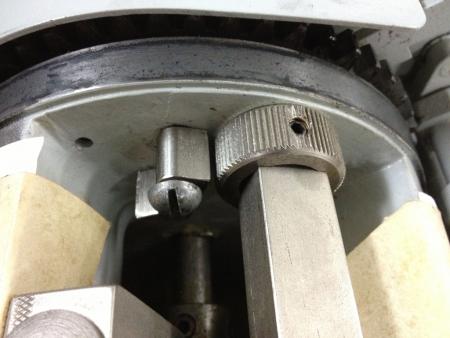The pawl on this Uni III is facing the opposite way?
Would there ever be any variation in any Vandercook series’ of the direction of the pawl & its toothed gear buddy? Every Vandercook I’ve ever changed a drawsheet on had it facing this way (image) but on this Uni III, it is facing the opposite way. When I unscrewed the pawl and flipped it around it became clear that the teeth in the ratchet gear are running the opposite way also so I supposed that was why the owner had it like that but as is, I can’t tighten this around the bar to save the life of me! I doubt that ratchet system would ever vary, but I’ve been wrong before. What do y’all think?

img_7456.jpg
The pawl can be flipped so that the pawl latches underneath.
Keep this in mind. When the teeth on the ratchet slopes from NW to SE, the pawl latches into top and the draw sheet tail winds underhand (clockwise) around the reel rod. When the teeth on the ratchet slopes from NE to SW, the pawl latches into underneath and the draw sheet tail winds overhand or (counterclockwise) around the reel rod.
It may be that the teeth on the ratchet are worn in the area that you need. A set screw can be loosened and turned on the reel rod.
The orientation shown in the photo is the most common, but you can find numerous examples of the opposite arrangement on various models.
Another take (which may be completely wrong, apologies if so!!)
Remove the *pawl* via the cheese-head screw, (which looks a little >wrong font,?<) flip it 180 degrees in Plan View, probably find a tiny hole, in the back, which should be the front??? to match and correspond to the PICTURED, tiny hole at, five past one, (cylinder body/bearer) to accomodate the Hairspring to keep the Dog/Pawl in contact with the teeth of the ratchet wheel.
The orientation of the respective holes should determine the position of the pawl for operation, including distinct *V* at the working end,***and distinct extension opposite, for release when unwinding or replacing the Tympan Packing/Draw sheet.
****On close examination of the Pawl, possibly, would also expect to seen wear marks, on the actual tip of the pawl, including signs of, or attempts to, re-profile prior to replacement… Usually regarded as Sacrificial rather than the draw-bar unit.
Again on offering the pawl up to the ratchet wheel on the draw bar, it would be usual to see signs of wear from the pawl, indicating where precisely IT (the pawl) has contacted the ratchet wheel in times past, as the shot, 7456 appears to show, the pawl, is a small percentage wider than the ratchet wheel and will probably show 1/16” unworn section of the *V* possible clues.!! = Bevel Contour at exposed end.??
Apologies again for rubbish.
Some Vanderooks draw the tail of the topsheet over the reel, some draw it under. The difference is that all the models that draw over have a modified reel, either with a clamping piece that snaps into place, over die-cut pinholes in the topsheet, or a slit that the tail is drawn through. The models that draw under can hold the tympan just through internal tension (in the same way that production cylinder presses hold the tympan). When the tail is formed around the reel, the change in direction—down over the tail of the cylinder and then up under the reel—creates a tension that can’t happen when the the tail goes over the reel straight from the cylinder.